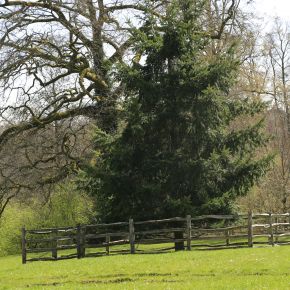Pseudotsuga menziesii
(Douglas Fir)
Family - Pinaceae
Category - Conifer, Tree
Origin - Western North America
Discovered By - Archibald Menzies in 1792
Year of Introduction - Introduced by David Douglas in 1827
Season of Interest - Spring, Summer, Autumn, Winter
Hardiness - H6
Height - 25m to 50m or more
Width - 6m to 10m
Location - The Grounds, The Stumpery
Description: A large-sized, Evergreen coniferous tree of great importance to the timber trade. Pseudotsuga menziesii has a conical habit when young. Once mature, the lower branches are descending, the upper branches horizontal to ascending and the overall shape becomes more columnar. Linear, grey-green needle leaves are arranged in spirals around the stems. Monoecious. The yellow pollen cones are narrow and cylindrical in shape and reach approximately 2cm in length. The pendent, seed cones have protruding, three-pointed Bracts and are green when they emerge, maturing to reddish-brown.
The tallest tree in Britain is a Douglas Fir measuring over 65m and is growing in Reelig Glen near Inverness in Scotland.
The common name, Douglas Fir, is in reference to plantsman and plant hunter, David Douglas, who introduced the tree in 1827. Tragically, Douglas died at the age of 35 after being gored by a bull.
Although introduced by David Douglas, Pseudotsuga menziesii was discovered by and named for Archibald Menzies, a naval surgeon with a keen interest in plants.
Synonyms include - Pseudotsuga taxifolia, P. douglasii
Foliage:
Slender, grey-green needles are short, sharp and spirally arranged on the branches.
Foliage Senescence: Evergreen
Foliage Shape: Needle
Propagation:
Seed.
Cultivation:
Best in full sun in moisture retentive, but well drained soil.

